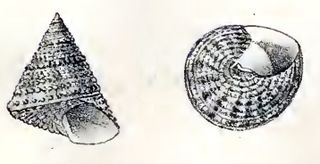
Calliostoma fragum is a species of sea snail, a marine gastropod mollusk in the family Calliostomatidae.

Drupella cornus, common name : the horn drupe, is a species of sea snail, a marine gastropod mollusk in the family Muricidae, the murex snails or rock snails.
Drupella eburnea is a species of sea snail, a marine gastropod mollusk in the family Muricidae, the murex snails or rock snails.
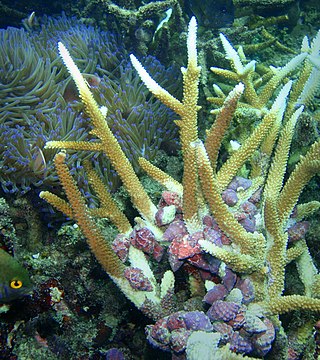
Drupella rugosa, common name : the rugose drupe, is a species of sea snail, a marine gastropod mollusk in the family Muricidae, the murex snails or rock snails.

Ergalatax margariticola, common name : the shouldered castor bean, is a species of sea snail, a marine gastropod mollusk in the family Muricidae, the murex snails or rock snails.

Cronia is a genus of sea snails, marine gastropod mollusks in the family Muricidae, the murex snails or rock snails.

Drupa is a genus of sea snails, marine gastropod mollusks in the family Muricidae, the murex snails or rock snails. It occurs in the Indo-Pacific.

Drupella is a genus of sea snails, marine gastropod mollusks in the family Muricidae, the murex snails or rock snails.

Ergalatax is a genus of sea snails, marine gastropod mollusks in the subfamily Ergalataxinae of the family Muricidae, the murex snails or rock snails.
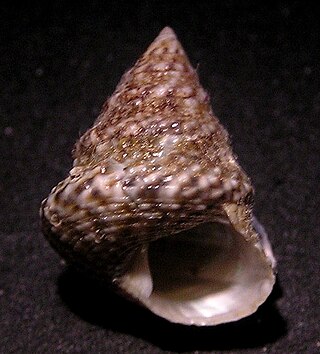
Calthalotia is an Australian genus of sea snails, marine gastropod molluscs in the family Trochidae, the top shells.

Favia is a genus of reef-building stony corals in the family Mussidae. Members of the genus are massive or thickly encrusting colonial corals, either dome-shaped or flat, and a few are foliaceous. There is a great diversity of form even among individuals of the same species. The corallites project slightly above the surface of the coral and each has its own wall. In most species, the corallites are plocoid and in some, monocentric. The septa and costae linked to the corallite wall are well developed and covered by fine teeth. The polyps only extend and feed during the night. Each one has a small number of tapering tentacles which often have a darker coloured tip; these are called stinger tentacles, or sweeper tentacles. They use these to sweep the water to see if any other coral is in its area; if so, then they begin to sting the other coral. This is commonly known as coral war. Each coral is trying to make sure it has enough room around it so it can continue to grow and have more surface area for its offspring. The columella is parietal and spongy, and there are vesicles on both the endotheca and exotheca. Members of this genus are widespread in both the Atlantic Ocean and the Indo-Pacific.
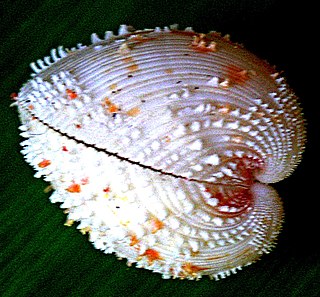
Fragum is a genus of cockles, marine bivalve molluscs in the family Cardiidae. Members of the genus have characteristic thick, sculptured shells and live buried in sand, extending their siphons to the surface to feed and breathe. They are found in the Indo-Pacific region and the Red Sea.

Fragum unedo is a species of cockle, a marine bivalve mollusc in the family Cardiidae, commonly known as the Pacific strawberry cockle. It is found in tropical seas in the Indo-Pacific region and the empty shells are prized for use in decorative crafts.

Thalotia is a genus of sea snails, marine gastropod mollusks in the family Trochidae, the top snails.
Fragum fragum is a species of cockle, a marine bivalve mollusc in the family Cardiidae. It is commonly known as the white strawberry cockle and is found in the western Indo-Pacific Ocean. It is the type species of the genus Fragum.

Fragum erugatum is a small species of cockle, a marine bivalve mollusc in the family Cardiidae. It is found in the shallow seas off the coast of Western Australia. It is commonly known as the Hamelin cockle, cardiid cockle or heart cockle.
Calthalotia fragum is the common name of the spotted strawberry top shell or the comtesse's top shell, is a species of sea snail, a marine gastropod mollusk in the family Trochidae, the top snails.

A corallivore is an animal that feeds on coral. Corallivores are an important group of reef organism because they can influence coral abundance, distribution, and community structure. Corallivores feed on coral using a variety of unique adaptations and strategies. Known corallivores include certain mollusks, annelids, fish, crustaceans, flatworms and echinoderms. The first recorded evidence of corallivory was presented by Charles Darwin in 1842 during his voyage on HMS Beagle in which he found coral in the stomach of two Scarus parrotfish.
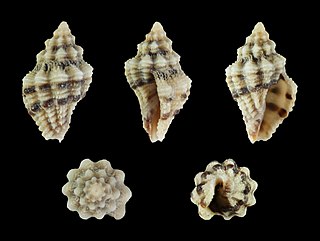
Drupella margariticola, common name the shouldered castor bean, is a species of sea snail, a marine gastropod mollusk, in the family Muricidae, the murex snails or rock snails.
Fragum nivale is a species of cockle in the family Cardiidae, that lives in the Western Indian Ocean, in benthic environments. It has a body length of 1.2 cm, and the embryos are developed into a swimming trochophore larvae, that resemble an immature clam.














